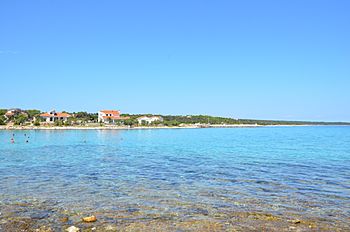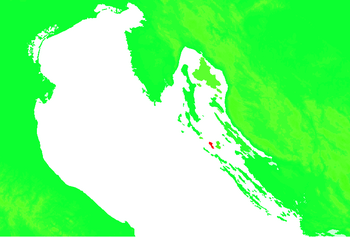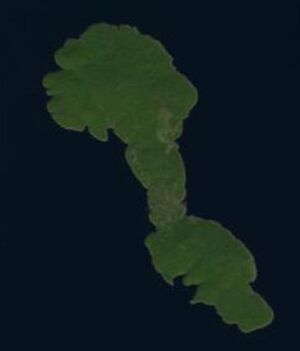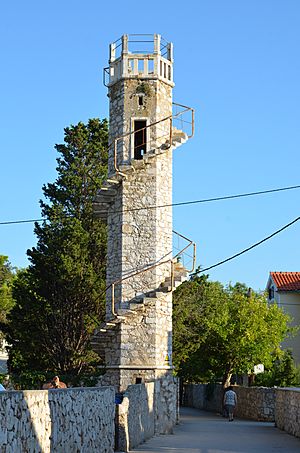Silba facts for kids

Sotorišće bay on Silba
|
|

Silba in Croatia
|
|
| Geography | |
|---|---|
| Location | Adriatic Sea |
| Coordinates | 44°22′N 14°42′E / 44.367°N 14.700°E |
| Area | 15 km2 (5.8 sq mi) |
| Highest elevation | 80 m (260 ft) |
| Highest point | Varh |
| Administration | |
|
Croatia
|
|
| County | Zadar |
| Demographics | |
| Population | 292 (2011) |
| Pop. density | 20.46 /km2 (52.99 /sq mi) |
Silba is a beautiful island in Croatia. It covers an area of 15 square kilometers. You can find it in the northern part of Dalmatia, which is a region in Croatia. It sits between the islands of Premuda and Olib.
Silba has a Mediterranean climate. This means it gets lots of sunshine, about 2570 hours each year! Summer days are often hot and clear. A gentle wind called the Maestral helps to cool the island in the afternoons.
The island looks a bit like the number 8. The main village of Silba is right in the narrowest part. You can walk from the Mul harbor in the northeast to the Žalić harbor in the southwest in about 10 minutes. This walk is only about 600 meters long.
About 292 people officially live on Silba. However, this number changes a lot throughout the year. In winter, only a few hundred people, mostly retirees, stay on the island. But in summer, thousands of people visit! Many islanders also have jobs and homes on the mainland. Tourism is now the main way people make money on Silba.
The whole island is a pedestrian zone. This means no cars are allowed, except for vehicles that deliver supplies to local shops. Silba is part of Zadar County, and Zadar is its main administrative center on the mainland.
Exploring Silba's Geography
Silba has many small beaches and hidden coves. The main public beach is called Sutorišće. It is near the Mul harbor. This beach has very clear, shallow water and a sandy bottom. At Žalić, you will find several pebbly beaches and a pier where ships dock.
You can reach many coves outside the village by walking along footpaths. On the southern side of the island, about 30 to 45 minutes walk away, you will find:
- Vele Stene (Large Rocks): This is the only place on the island where the shores are steep and rocky.
- Port Sv. Ante: This port is popular with people who sail yachts. It is safe from strong winds. You can also see a small chapel by the bay.
- Dobre Vode: This beach has a shallow, sandy bottom.
- Nozdre: This is a large cove with cool, flat rock formations shaped by the sea.
On the north side of the village is the highest point on Silba, called Varh. It is 86 meters high. The northern shore is harder to reach because it is rocky. However, there is a path leading north from the village to a small port called Papranica. If you walk further, about an hour from the main village, you will reach Pernastica cove. Many people think this is one of the nicest coves on the island. It faces west, so you can watch the sunset, and it has a long, shallow, sandy bottom.
One of the most famous symbols of Silba is the "Torretta Marinich." This is a hexagonal (six-sided) observation tower. It is 15 meters tall and has a spiral staircase on the outside. Captain Pietro Marinich built it in 1872 in his family garden. A small chapel was added next to it in 1894. The tower is in the center of the village, right on Veli Put, which is Silba's main street.
The village has several cafes, four restaurants, and many shops. There is also a post office and a local doctor. From anywhere in the village, you can walk to the nearest beach in about 10 minutes or less.
Silba's Past: A Look at Its History
The old name for Silba was Selbo. People think this name came from the Latin word "Silva," which means "forest." Silba is first mentioned in history books in the 9th century. In 827, it was part of the Zadar county.
Later, in 1073, the island was given to the St. Maria monastery in Zadar. This happened during the reign of King Petar Krešimir. After that, the island came under the control of the Republic of Venice. The Venetians then sold the island to a captain named Fani Soppe for 12,350 ducats.
It is not clear how the Venetian family Morosini later owned Silba. The Morosini family owned Silba until the early 1800s. Since it was hard for them to collect taxes in crops, they made a deal with the people of Silba in 1770. The islanders would pay 2000 Venetian lira in rent each year. The people of Silba called this rent četvrtina, meaning "quarter." This was because it was about a quarter of what the land produced, similar to what farmers paid elsewhere.
In 1838, the Morosini family sold the island to Marko Ragusin from Veli Lošinj. He had become rich in the United States. The island was sold for 28,500 Austrian lira.
The people of Silba had been paying rent in money to the previous owner. They thought they would do the same with the new owner. But Marko Ragusin lived close by in Lošinj. He wanted a quarter of the crops instead of money. This led to a lawsuit that lasted 13 years! Finally, Ragusin decided to sell the island to the islanders themselves. Each person paid based on the size of their land. In total, they paid 5,025 Bavarian thalers. On March 19, 1852, the islanders officially became the owners of Silba. This day became a special holiday on the island, celebrated as St. Joseph's Day.
In the 18th century, Silba had a large fleet of ships. It had 38 sailing boats with three masts, called Manzere, and 60 sailing boats with two masts, called Kastrere. These ships helped the island become wealthy. However, the French destroyed this fleet in the early 1800s. An old local saying shows how rich the island once was: "Silba shines with gold, on it heavenly enjoyment."
In the past, there was a special custom of electing a "village king." The king was chosen on Saint Stephen's Day (December 26). His rule would last until Three Kings (January 6). During his twelve days as king, he would wear a crown and be surrounded by twelve advisors. He would lead village meetings and make decisions. His job was to choose the village head and guards. He also approved the budget from the past year and planned for the next. He would settle any complaints or disagreements that had happened during the year. This custom ended in the early 1800s. The king's crown is still kept in the parish church's treasury.
In 1943, Silba was the site of a naval battle during World War II.
See also
 In Spanish: Silba (isla) para niños
In Spanish: Silba (isla) para niños



